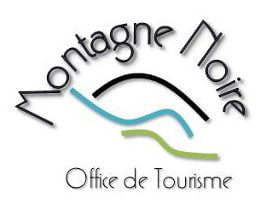Our selection of restaurants around your campsite near Carcassonne
During your stay at the campsite, take the opportunity to sample the specialities of the Aude region. Discover the talent of our chefs by making reservations at restaurants close to the campsite, some of them in picturesque locations. Whether you’re looking for a gourmet meal or a quick lunch, you’ll find a variety of choices in the Brousses et Villaret area. Here are some of our favourite establishments
Restaurant le Lauthier – 1km
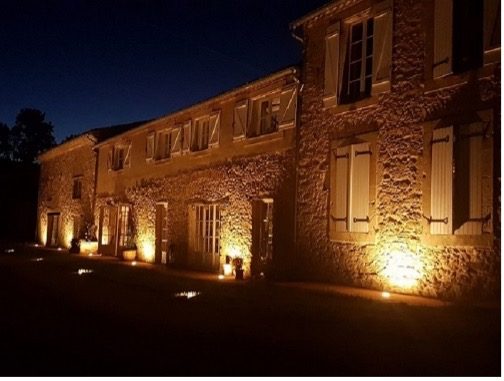
Located in Brousses, 1 km from the campsite, Le Lauthier welcomes you in its large stone-walled dining room or in the shade of its tall trees, where you can enjoy themed tapas dishes such as the “assiette tout canard” or the “assiette de la mer”. Finish your meal with Elody’s delicacies.
Domaine Lauthier Haut
06 86 66 69 36
elody@lelauthier.fr
Le 7ème péché, Tearoom 1km from the campsite

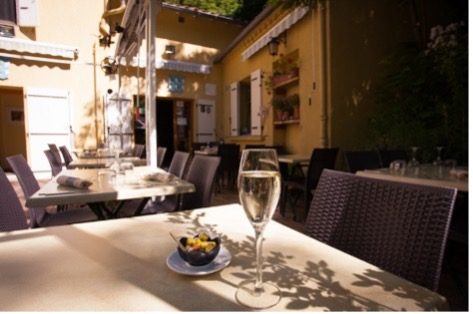
Domaine Lauthier le Haut
06 17 21 11 92
elody@le7emepeche.com
www.le7emepeche.fr
Bar-Restaurant La Prise d’Alzeau – 9 km from campsite,
Under cool trees, next to the Alzeau River, the restaurant serves traditional and creative home cooking in a serene, invigorating setting. There’s a wonderful walk along the Rigole, on foot or by bike, available for hire from the campsite.
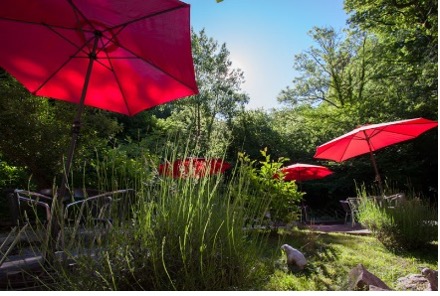
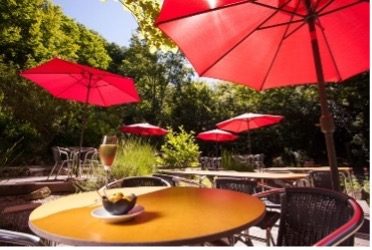
La Forge, Lieu-dit Prise d’Alzeau
04 68 25 46 94
prisedalzeau@gmail.com
www.prisedalzeau.com
Auberge de Pantouquet – 7 km from campsite

In this restaurant, 7 km from the campsite, you can enjoy wood-grilled meats, snails and other generous dishes, in summer facing the small lake and in winter by the wood-burning stove.
L’Estanquet De La Chapelle – 7km from campsite
Located in Caudebronde, 7 km from the campsite, this Snack/Bar offers excellent dishes and delicious meats at affordable prices.
3 chemin Saint-Pierre
04 68 76 40 13
L’Estanquet de la Chapelle
Les Trois Fontaines – 13 km
Bar/restaurant 13 km from campsite
23 Route de Mazamet
11390 les Martys
04 68 26 59 22
L’Auberge de l’Orbiel – 17 km
Located in Lastours (17 km from the campsite) at the foot of the four castles, this inn offers traditional French cuisine. Open every day of the week from 10am to 6pm and evenings by prior arrangement.
16 route des 4 châteaux
04 68 77 18 07
L’Evasion – 5 km
Located in Cuxac-Cabardès (5km from the campsite), L’Evasion is a bar/restaurant offering a wide range of cuisine
Reunionese and Creole. This restaurant offers takeaway sales.
Thé and Co – 5km
Organic restaurant in Montolieu (5 km) and Boutique du Terroir
3 place Jean Guéhenno
04 68 79 80 12
Café du Commerce – 5km
Restaurant – Pizzeria in Montolieu (5km from campsite)
1 place des Tilleuls
0468248512
Cap and hat
Restaurant in Montolieu (5km from campsite)
2 Place de la liberté
04 68 24 76 72
Book your accommodation or campsite at Le Martinet Rouge now!
Markets around Carcassonne in the Aude department
Discover the local products of the Aude region, the scents and flavors of the markets around the Brousses et Villarets, Le Martinet Rouge campsite. We propose you the list and the days of markets around the campsite.
BROUSSES and Villarets
Tuesdays from 5:30pm to 10:30pm. Just 500 metres from the campsite, enjoy this enchanting market! Regional products (fruit and vegetables, bread, cheese, oysters, mussels, charcuterie, etc.), arts and crafts, local beer and wine tastings, etc. A real weekly meeting place, the atmosphere on the village’s Place des Cèdres is part traditional market, part guinguette! Foodtrucks, cheese platters, shellfish and other delicacies are available to enjoy on the spot, in a musical atmosphere provided each week by different groups of musicians. Festive and local, the Brousses market is a must when you stay at the campsite!
Carcassonne
Tuesday and Thursday mornings (fruit and vegetables)
Saturday mornings (second-hand goods, fruit and vegetables)
Sunday morning at Place de la Barbacane (local producers’ market)
Mirepoix: every Monday morning, Mirepoix comes alive with its large market where you can stroll and find fruit, vegetables, meat, fish, spices, textiles, jewelry, handicrafts… all in a friendly, colorful atmosphere.
Revel: every Saturday morning from 7am, the central square comes alive with a market renowned for the quality of its produce, ranked among the 100 most beautiful markets in France.
Mazamet: Summer Mondays from 5pm to 10pm, barracks parking lot. Farmers’ market, artisan demonstrations, tastings and gourmet plates of farm produce. Musical entertainment and games for children.
Trèbes : Sunday morning
Alzonne: Thursday morning
Bram: Wednesday morning
Caunes Minervois: Tuesday morning
Castelnaudary: Monday morning
Limoux: Friday, 8 a.m. to 4 p.m.
Narbonne Front de mer: Tuesday, Thursday and Saturday mornings
Gruissan: Monday, Wednesday and Saturday mornings
Saint Pierre la mer: Every morning
Book your campsite rental now.
Book your pitch for tent, caravan or motorhome now.
Cassoulet de Castelnaudary
Cassoulet is not just a recipe whose origins are disputed, it’s also part of the heritage of the Cathar region of southwestern France.
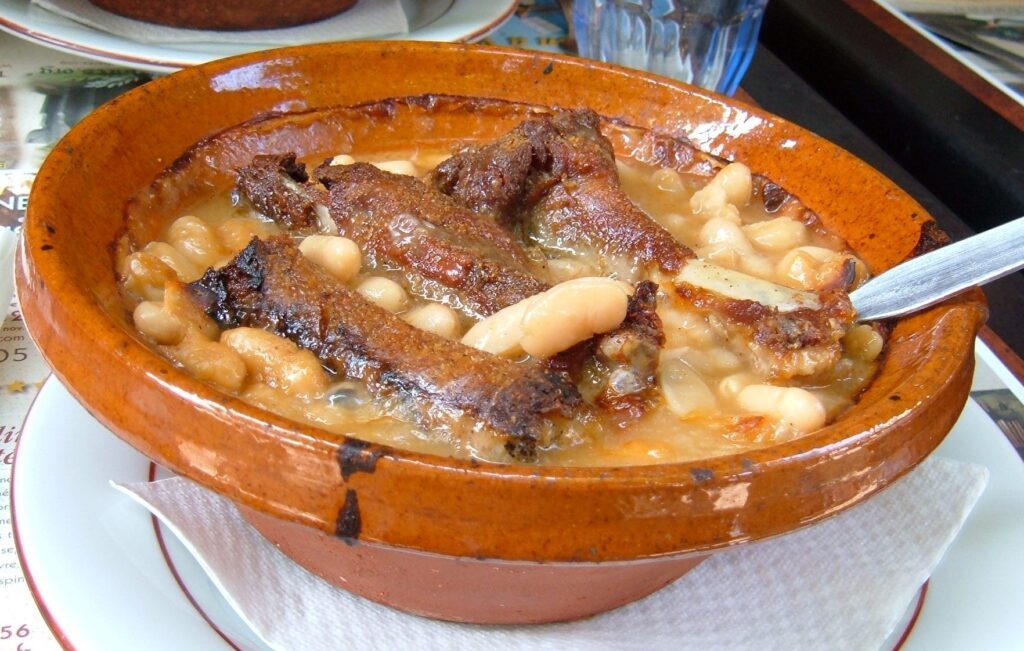
Photo credits: BrokenSphere [CC BY-SA 3.0 (https://creativecommons.org/licenses/by-sa/3.0)]
In response to the many questions you’ve asked us when visiting your campsite near Carcassonne and Castelnaudary, we’ve decided to devote an article to it, and above all, to give you the real recipe for Castelnaudary Cassoulet.
The origin of the Cassoulet recipe
Its origins date back tomedieval times, around the 14th century. The recipe’s creator is said to be Guillaume Tirel, known as“Taillevent“, cook to kings for over 60 years. The first mention of this dish appears in his cookery book “Le Viandier”, which refers to a mutton and pork stew with broad beans. Some historians theorize that he was inspired by a recipe borrowed from the Arabs, which emphasized spices and herbs. Sheep stew with white beans is one of the recipes in the Baghdad Culinary Treatise. Taillevent would have taken this recipe and adapted it. Beans were later replaced by ingot beans, imported from South America by Christopher Columbus in 1530.
The story
Legend has it that the inhabitants of Castelnaudary, threatened by famine during the English siege of the town, pooled everything they had to feed the town’s soldiers. Bacon, pork, beans, sausages and meat were all simmered in a large bowl.
The soldiers, full of energy, drove the English out of the Lauragais and to the English Channel!
Where does the name Cassoulet come from?
Cassoulet gave its name to the dish in the 18th century. Its name comes from the“cassole“, a terracotta vessel glazed on the inside to make it non-porous, produced in the village of Issel, north of Castelnaudary. The mythical local dish simply took its name from the vessel in which it was cooked.
Cassoulet recipe for 4 people
“Ingredients
- 350-400 g lingot beans (preferably from the Lauragais region)
- 2 duck or goose confit legs, halved.
- 4 – 80g pieces of pure pork “Toulouse” sausage.
- 4 – 50g pieces of pork from the shank, shoulder or belly
- 250 g pork rind, half of which will be used after cooking to assemble the cassoulet.
- A little salted bacon
- 1 poultry carcass or a few pork bones onions and carrots
The Recipe
The day before: Soak the dried beans overnight in cold water.
The next day:
- Pour off the water, place the beans in a saucepan with three liters of cold water and boil for 5 minutes. Turn off the heat, drain the water and set the beans aside.
- Prepare the stock with another 3 liters of water (non calcareous and from Castelnaudary if possible), the rind cut into wide strips, a poultry carcass if available or a few pork bones and, to taste, a few onions and carrots. Season generously with salt and pepper. Cook for an hour, then strain the stock and remove the rind.
- Place the beans in the filtered stock and cook until they are soft but still whole. This takes about an hour of boiling.
While beans are cooking, Meat preparation :
- Degrease the pieces of confit in a large frying pan over low heat, then set aside.
- Brown the Toulouse sausages in the remaining fat, then set aside.
- Brown the pork pieces until golden brown and set aside with the other meats.
- Drain the beans and keep the stock warm. Add to the beans a few cloves of garlic and double the weight of salted bacon, crushed together.
Cassoulet assembly:
To do this, use the hollow terracotta dish known as “cassolo” (now called “la cassole”) which gave its name to cassoulet, or alternatively a fairly hollow ovenproof terracotta dish.
- Line the bottom of the cassole with pieces of rind
- add about a third of the beans
- arrange the meats and pour the rest of the beans on top
- Arrange the sausages by pressing them into the beans, leaving the top of the sausages visible.
- Complete the cassole by pouring in the hot broth, which should just cover the beans.
- Grind pepper on the surface and add a tablespoon of the duck fat used to brown the meats.
Cooking :
- Place in the oven at 150°/160° (Thermostat 5 or 6) and bake for two to three hours.
- During baking, a golden-brown crust will form on the top of the cassole, which needs to be pressed down several times (the ancients used to say 7 times).
- When the top of the beans begins to dry, add a few spoonfuls of stock.
If you prepare this cassoulet the day before, it should be reheated in the oven at 150° for an hour and a half before serving. Don’t forget to add a little broth or, failing that, a few spoonfuls of water.”
source:recipe and historical sources taken from the website of the Grande Confrérie du Cassoulet de Castelnaudary, a comprehensive site on the history of cassoulet.
The wine that goes with Cassoulet
Choose AOC Malepère, wines from the Malepère massif. Produced on the outskirts of Carcassonne, its fruity bouquet is a perfect match for this flavorful dish.
Did you know that there is a Cassoulet road? Discover it here
Enjoy the tasting and see you soon at your campsite near Carcassonne.
tags: cassoulet recipe, camping near carcassonne, camping aude, castelnaudary
Languedoc wines appellation Cabardès
Your campsite is located in the heart of the Cabardès vineyards, an AOC appellation covering 550 hectares of vines south of the Montagne Noire, close to your Le Martinet Rouge campsite. The soil is not very fertile, but is particularly well-suited to quality production.
Cabardès is the only wine that blends grape varieties of both Mediterranean and Atlantic origin: Merlot and Cabernet Sauvignon for the Atlantic, and Syrah and Grenache for the Mediterranean.
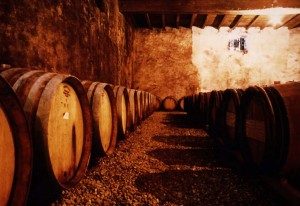
The dominance of strong winds from the Atlantic Ocean provides the maritime air that allows the Cabernet Sauvignon and Merlot grape varieties to flourish, giving this wine its characteristic taste, with structured tannins and aromas combining fruit such as blackcurrant and plum with notes of smoke and leather… while the southern grape varieties, which appreciate the sun, flourish in the warm, dry Mediterranean climate. On the nose, these crus give off scents of garrigue, spices and liquorice.
The Cabardès appellation, anAude wine to be enjoyed absolutely (in moderation!)
Cabardès wines
Cabardès, under the cross winds of east and west, takes on a singular balance, developing in its aroma all the sweetness of the Mediterranean with the vivacity of the ocean. Two AOC wines:
Cabardès red wines with a deep red color.
Nose: aromas of blackcurrant liqueur, black cherry, candied fruit, violet, leather.
Palate: velvety, powerful, complex.
Cabardès rosé wines in a wide range of colors.
Nose: intense, clean aromas of red fruit, raspberry, strawberry. Very tasty.
Palate: fruity, lively and typical. Beautiful roundness with crunchy fruit.
The confidentiality of the Caberdès AOC wine makes for good cohesion between wineries and producers.
The history of Cabardès wine
Introduced by Greek merchants in the 2nd century, wine production in the region really took off under Roman occupation.
But it was the monks of the abbeys of Lagrasse, Caunes-minervois, Fontfroide and Saint-Hilaire who drove viticulture forward.
The country embraced the Cathar religion, which authorized wine production in the region, but adherence to the dogma led to the destruction of vines by the soldiers of the Albigensian crusade, notably Henri de Beaujeu. Then came the Black Prince, who had what remained of the vineyards uprooted during his incusrion in Languedoc during the 100 Years’ War.
It wasn’t until the completion of the Canal du Midi in 1681, which linked the Mediterranean and the Atlantic, that modern vineyards were once again established and trade progressed. Two successive crises, one caused by powdery mildew and the other by phylloxera, led to a revolt by too many growers.
The winegrowers then organized themselves into a cooperative, prioritizing quality over quantity, and in 1999 obtained the AOC for Caberdès wines.
The AOC comprises 4 cooperative wineries and 18 private wineries, representing around 300 winegrowers. Many offer tasting cellars for the public to discover the quality of their vineyards, glass in hand.
Visit the Aude, a wine-growing region on the wine route
Cabardès is also a land to discover, just a few kilometers from Carcassonne, where old stones charm you in villages nestled at the foot of the Montagne Noire. Aragon, anchored on a rocky outcrop and surrounded by the Cabardès vineyards, offers a superb panoramic view of the region. The village of Montolieu offers a haven for book lovers, with its narrow streets lined with second-hand booksellers, bookshops and art craftsmen, as well as a Museum of Book Arts and Crafts.
Other walks for history buffs: the Château de Pennautier, the Vilelongue abbey, the Brousse paper mill or the drystone capitelles, the museum of old winegrowers’ tools.
Finally, the
Canal du Midi
is an invitation to silence and meditation in the midst of lush greenery, providing the perfect backdrop for sporting activities and hiking escapades… What a program!
Book your mobile home in Carcassonne – Your pitch in Aude
camping Cabardès, camping Aude





